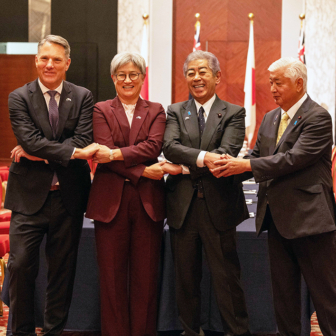We have a tendency to overestimate how unified our political adversaries are, because of a particular version of what psychologists call the “fundamental attribution error.” When we look at our own side, we all too easily see the incoherence, the petty feuding, bickering and incompetence. When we look at the other, it appears to be possessed by a single purpose, marching in lockstep to a coherent, evil plan. It’s harder to think this way about so disorganised an administration as Donald Trump’s, but we (for values of “we” that include me) still regularly fall into the trap.
That may be why there has been less discussion than there might be of the disagreements within Trump’s coalition. In addition to the personal rivalries and backbiting, there’s a big, obvious ideological fissure between the hardcore religious right and Silicon Valley. For a while, I’ve wondered about the weirdness of J.D. Vance’s position, as both the regime’s chief advocate for TradCath integralism, and most prominent connection to the Silicon Valley right. The angel of tradition on one shoulder whispers: keep the modern out! An imp of wickedness on the other: let innovation rip! The one eternally contends against the other.
Just over a week ago, Vance gave a speech at the “American Dynamism Summit,” which made the contradiction clear. As with any politician’s speech, it is anyone’s guess how much is Vance himself, and how much his speechwriter. But the speech was very clearly all about the awkward relationship between Common Good Conservatism and Let Software Eat The World. When a politician specifically and repeatedly denies that a tension is important, it is excellent evidence that the tension is urgent and worrying. This tension is by no means necessarily a sign of imminent collapse. Previous conservative coalitions, such as National Review “fusionism,” had spotty welding in places, but somehow held together for decades. Still, it is a visible weakness that might be exploited.
The point is this. It is not just that the American right is becoming more extreme, but that its extremism pulls in two radically different directions. One faction yearns to return to the cultural stability of a world in which everyone agrees (or is obliged to agree) on shared values, and the only legitimate arguments are about how best to achieve the worldly version of the kingdom of heaven. The other fantasises about a radical acceleration of the forces of change, ripping society apart in the name of perpetual innovation. Moving towards the one means moving directly away from the other.
The two clashing tendencies respectively centre around integralism and right-accelerationism. Providing detailed accounts of the two would take a lot of words but you need at least a very rough sense of the two to understand the tension and how Vance is trying to reconcile it.
The simplest way of describing integralism is as the proposition that society ought be shaped by agreement on a common good that in turn reflects Christian natural law. If you believe that God has told us how we should lead our lives, then shouldn’t our society and our government reflect these values? There will be complications and compromises — the City of God is not the City of Man — but still you ought do what you can to build the worldly paradise.
What animates this vision is not simply the belief that there is a right way to order society, but the contention that the radical plurality of modern liberalism is morally wrong. According to integralism, government and society ought not reflect continued disagreement among different paths of life and values but agreement on the good. As Kevin Vallier puts it, integralists and their brethren in other religious faiths “often support an extensive state that adopts one of the great religions and shapes people to fit within that faith. Anti-liberals seek to alter or abolish liberal orders, and they oppose all liberal political and ethical theories.”
In the integralists’ preferred political system, there will still be disagreement and political conflict, but it should occur within an appropriate moral order from which there is no legitimate exit. Religious minorities can be tolerated, under some conditions and so long as they do not look to upset the principles of the society that they live in. Efforts to remake politics so that it reflects the fact that people profoundly disagree over how to live the good life are not allowable.
Accelerationism of the Silicon Valley variety takes just the opposite stance. According to right-accelerationists, the best political order is “exit” all the way down (or, more precisely, exit between one CEO-founded microsociety and another). In their radicalised version of market liberalism, if you demolish the state, and allow unhindered innovation, our descendants will find their way to the stars.
This is (or claims to be) a vision of unfettered freedom. In Marc Andreessen’s account: “We believe technology is liberatory. Liberatory of human potential. Liberatory of the human soul, the human spirit. Expanding what it can mean to be free, to be fulfilled, to be alive. We believe technology opens the space of what it can mean to be human.” In practice of course, this politics is far murkier than the exhortations suggest (fulfillment and openness for the hero-founders of Silicon Valley who discover new possibilities; humble gratitude for their vision from everyone else). But the explicit goal is to open up space for different versions of the human, rather than to constrain to one.
There are lots more complications, variations and disagreements within both these tendencies. But the basic problem that Vance confronts, and to some extent himself embodies, should be obvious: they cannot easily be brought to agree with each other. So how does Vance reconcile an anti-liberalism that wants to tamp down society, rejecting modernity and all its ways, with a turbocharged vision of a radically unconstrained future in which society evolves in a myriad different directions?
With difficulty. After the usual opening inanities, Vance’s speech lays out the problem accordingly.
One journalist, he said, had suggested that his speech on AI in Paris had “highlighted the tension between the, quote, ‘techno-optimists’ and the ‘populist right’ of President Trump’s coalition”:
And today, I’d like to speak to these tensions as a proud member of both tribes. And let me put it simply: While this is a well-intentioned concern, I think it’s based on a faulty premise. This idea that tech-forward people and the populists are somehow inevitably going to come to a loggerheads is wrong.
Why not? Vance provides two justifications. The first is that “[r]eal innovation makes us more productive, but it also, I think, dignifies our workers.” Hence, technological innovation doesn’t hurt traditional society but cements it. The second is that they share a common enemy: the mindmeld between the American state and economic globalisation. Rolling back globalisation will be good for American entrepreneurialism.
[T]he role that technology plays in a labour market, and whether we greet innovative breakthroughs with excitement or with trepidation depends on the purpose of our economic system in the first place. And I think this is where the populists have an important point. It should be no surprise that when we send so much of our industrial base to other countries, we stop making interesting new things right here at home.
More generally:
[E]ach group — our workers, the populace on the one hand, the tech optimists on the other — have been failed by this government — not just the government of the last administration but the government, in some ways, of the last forty years, because there were two conceits that our leadership class had when it came to globalization… The first is assuming that we can separate the making of things from the design of things… the second is that cheap labour is fundamentally a crutch, and it’s a crutch that inhibits innovation. I’d ask my friends, both on the — the tech optimist side and on the populist side, not to see the failure of the logic of globalisation as a failure of innovation… Both our working people — our populists — and our innovators gathered here today have the same enemy. And the solution, I believe, is American innovation, because, in the long run, it’s technology that increases the value of labour.
That is why
to come full circle on this tension — alleged tension between the populists and the techno-optimists, I can understand a reaction of scepticism when we talk about the revolutionary potential of new invention and artificial intelligence and all the other incredible technologies that you guys are working, but I think that that tension is a little overstated.
The problem for Vance is that the tension is not overstated at all. The Silicon Valley right has enthusiastically embraced the US versus China framing of global politics but is still strongly committed to globalisation. Right-wing accelerationism is not a backlash against globalisation and its combination of exit and constraint, but an argument that its logic should be extended downwards into the nation state. Grandiose claims about the “sovereign individual” and “network state” are so many arguments for replacing the nation state with an alternative that combines economic exit with corporate rule.
This is one variant of a more general Silicon Valley orientation towards the world. As David Broockman, Greg F. Ferenstein and Neil Malhotra documented back in 2019, Silicon Valley entrepreneurs are globalisation-pilled:
On policies related to globalism, technology entrepreneurs are the most pro-globalism of any of the groups save for Democratic donors (0.14 to 0.36 scale points greater than the other groups, p < 0.01). For example, technology entrepreneurs are the most likely to say that trade policy should prioritise the wellbeing of those abroad instead of Americans (with 44 per cent agreeing), to disagree that we should pay less attention to problems overseas (with 53 per cent disagreeing), and to support free trade agreements (87 per cent). 56 per cent favour increasing levels of immigration, essentially equal to Democratic donors and more than any other sample, including fifteen points higher than Democratic citizens.
So too for the claims that innovation will actually enhance the dignity of workers rather than take it away. If you’re prepared to squint a bit, this seems to resemble the claims of technology-focused progressives and moderates such as Daron Acemoglu and Simon Johnson on the one hand, and Erik Brynjolfsson on the other. These latter thinkers argue for the benefits of labour-enhancing technology, and say we should build a trajectory that achieves those benefits.
But Vance is not arguing for choosing a worker-friendly trajectory, as far as I can see. Instead, he seems to believe that innovation as such benefits workers. As in Andreessen’s manifesto, the claim seems to be that technological change necessarily augments the value of work and hence the lives of workers. Hence, you can have both disruption-focused entrepreneurs and workers who want dignity in the same right-leaning political coalition.
At least, you can have them both as long as you don’t actually pay attention to how Silicon Valley honours the contention that innovation “dignifies” workers in the breach, not the practice. One of the most prominent shared beliefs of Silicon Valley elites, according to Broockman, Ferenstein and Malhotra, is their hostility to organised labour, and to anyone who tries to tell them what to do with the people who work for them:
[T]echnology entrepreneurs dramatically differ from Democratic Party conventional wisdom in one key policy area with important implications for economic inequality: regulation, especially of the labour market. Technology entrepreneurs are much more sceptical of government regulation than other Democrats; even technology entrepreneurs who identify as Democrats are much more opposed to regulation than are other Democrats. Technology entrepreneurs also overwhelmingly hope to see labour unions’ influence decline.
More broadly, the chief impetus of the Silicon Valley model over the last couple of decades has not been to elevate workers but to replace them. If, for example, AI does not replace workers — and replace workers wholesale — it won’t make enough money to merit the dizzying valuations set in a series of funding rounds. Perhaps this will be in workers’ interests in the long run, but in practice, few people focus on putative long runs when they are at the brunt end of creative destruction.
That Vance felt the need to give this speech suggests to me that there is a widening crack in the coalition. Perhaps it can be papered over, as Vance clearly hopes. But also, perhaps not.
It’s notable that three words related to Trump, technology and work do not appear anywhere in the speech: “Elon,” “Musk,” and “DOGE.” I suspect that it is going to be particularly difficult for Vance and his ilk to make the case for common cause between technology companies and the interests of ordinary workers while DOGE is publicly stress-testing the common Silicon Valley belief that everything could be done better with lots more algorithms and far fewer workers, and while tech leaders opinionate that we soon won’t need humans for “most things.”
You can either look back to some lost TradCath Eden in which workers were valued and everyone knew their place, or look forward to a post-Singularity utopia where work as we know it has been radically transformed. But you can’t plausibly aspire to both at once, however much Vance wishes you could. •
This article first appeared in Henry Farrell’s Programmable Mutter.




